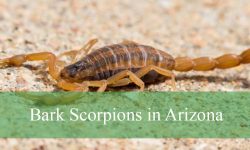Pennsylvania (PA) is home to various poisonous spiders that pose a threat to humans. Understanding their distinct features and potential dangers is essential for residents. Here are five common types of poisonous spiders found in PA, along with crucial details and pictures for easy identification.
Common Types of Poisonous Spiders in PA
1. Black Widow Spider (Latrodectus mactans)
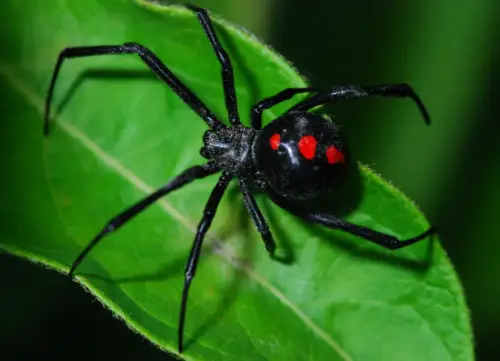
The black widow, scientifically known as Latrodectus mactans, is one of the most notorious spiders, feared for its potent venom and distinctive appearance. Characterized by its jet-black body and the striking red hourglass marking on its abdomen, the black widow commands attention with its ominous yet fascinating presence.
This arachnid is particularly recognized for its exceptional web-building abilities, crafting intricate, irregular, and tangled webs to ensnare its prey. The structural complexity of its web is a testament to the black widow’s predatory prowess, aiding it in capturing various insects and even small animals that unwittingly wander into its trap.
One of the most alarming aspects of the black widow’s behavior is its ability to deliver bites that often go unnoticed. This insidious characteristic, combined with its venom, creates a recipe for potential danger. The black widow’s venom is infamous for its neurotoxic effects, capable of interfering with nerve pathways and disrupting muscle functions. These disruptions can lead to severe symptoms, including muscle cramps, abdominal pain, sweating, and increased blood pressure, which can ultimately result in heart failure in extreme cases.
Despite its fearsome reputation, the black widow generally prefers to avoid human contact and only bites in self-defense or when unintentionally disturbed. Consequently, the frequency of black widow bites is relatively low compared to other spider species. However, encounters with this spider must be handled with caution and care to prevent any accidental provocation or unnecessary harm.
For those residing in areas where black widows are prevalent, adopting preventive measures is essential. Minimizing potential nesting sites, such as cluttered and undisturbed areas, and regularly inspecting surroundings for the presence of webs can help mitigate the risk of encountering these venomous creatures. In the event of a suspected black widow bite, seeking immediate medical attention is crucial to ensure proper treatment and management of symptoms.
2. Brown Recluse Spider
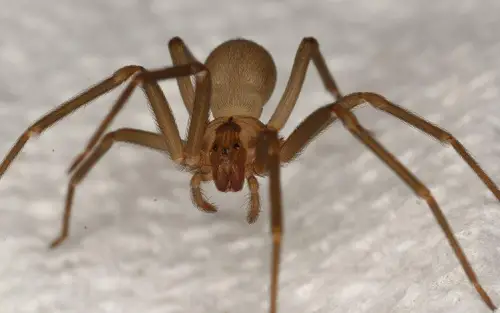
The brown recluse, characterized by its distinctive brown hue and violin-shaped pattern on its cephalothorax, is a prevalent arachnid species known for its reclusive behavior and potent venomous capabilities. Although they can get larger, brown recluse spiders typically measure between 6 and 20 millimeters (0.24 and 0.79 in). They might be pale, dark brown, or blackish gray in hue, though they are usually light to medium brown. The abdomen and cephalothorax are not always the same hue. This spider typically favors warm and dry environments, often seeking refuge in undisturbed areas or secluded locations within human habitats. Its inclination for concealing itself in dark and cluttered spaces allows the brown recluse to remain inconspicuous and avoid unnecessary confrontation, thereby minimizing the risks of exposure to potential threats or disturbances.
Despite its reserved nature, the brown recluse is equipped with venom that contains a complex mixture of enzymes and toxins, making its bite particularly hazardous and potentially debilitating. When the spider inflicts a bite, the venom’s components swiftly infiltrate the victim’s tissues, initiating a cascade of reactions that trigger a series of systemic and local manifestations. The initial symptoms of a brown recluse bite often include intense pain, characterized by a sharp and stinging sensation accompanied by localized inflammation and redness. These immediate effects can rapidly escalate, leading to the formation of necrotic lesions and ulcers as the venom progressively breaks down the surrounding tissue, creating a deep and persistent wound.
The destructive nature of the brown recluse’s venom is further underscored by its capacity to induce extensive tissue damage and provoke severe systemic reactions in some cases. Prolonged exposure to the venom can result in the development of necrotic wounds, leading to the formation of deep ulcers that may require extensive medical intervention and specialized wound care. The persistence of these wounds and the potential for secondary infections emphasize the critical importance of prompt and comprehensive medical attention to prevent the escalation of the injury and mitigate long-term health complications.
In light of the brown recluse’s potential threat to human well-being, individuals should exercise vigilance and adopt precautionary measures to minimize the risks of encountering this arachnid. Conducting routine inspections and maintaining a clean and clutter-free living environment can effectively deter the establishment of brown recluse populations and reduce the likelihood of unintended encounters. Additionally, implementing preventive strategies, such as sealing cracks and openings in structures and using appropriate pest control measures, can contribute to creating a fortified barrier against potential spider intrusions and minimize the opportunities for bites.
3. Broad-faced Sac Spider
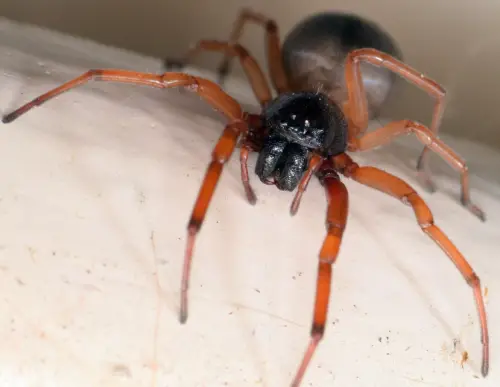
The broad-faced sac spider, distinguished by its distinct features of a black body coupled with striking red legs, is a notable arachnid species prevalent in various regions. This spider exhibits a preference for secluded habitats, frequently seeking refuge under leaf piles, boards, and windowsills, where it constructs intricate silk shelters for protection and concealment. Its ability to camouflage itself within its surroundings allows the broad-faced sac spider to remain hidden from potential threats while actively hunting for prey.
While the broad-faced sac spider may seem inconspicuous in its demeanor, its bite can elicit intense and often excruciating pain in its victims. The venom of this spider contains potent enzymes that can induce significant discomfort and distress, with immediate symptoms manifesting as sharp stinging sensations and throbbing pain around the affected area. Moreover, the initial bite wound can pave the way for severe secondary infections, complicating the healing process and necessitating prompt medical attention.
In some cases, individuals bitten by the broad-faced sac spider may also experience adverse systemic reactions, including localized inflammation, swelling, and redness. These symptoms can intensify over time, leading to the formation of pus-filled blisters and lesions, thereby exacerbating the discomfort and extending the recovery period. The severity of the bite’s aftermath underscores the need for vigilant monitoring and timely intervention to prevent the development of complications and mitigate the risk of long-term health implications.
Given the propensity of the broad-faced sac spider to inhabit human dwellings and frequently accessed areas, individuals should exercise caution and adopt preventive measures to minimize potential encounters. Regular inspection and maintenance of outdoor environments, such as the removal of leaf piles and debris, can effectively deter the proliferation of these spiders and reduce the likelihood of inadvertent contact.
Furthermore, the implementation of appropriate protective measures, such as wearing gloves and long-sleeved clothing when handling outdoor materials, can serve as an additional safeguard against potential spider bites.
4. Woodlouse Hunter Spider
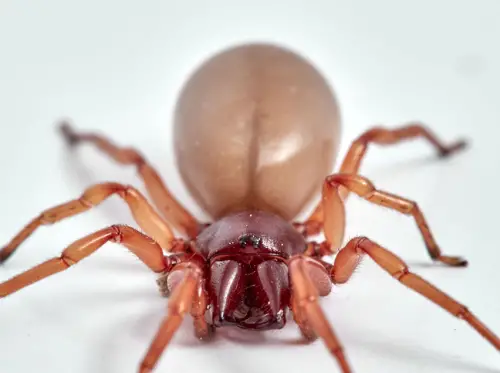
The woodlouse hunter, recognized by its distinctive reddish-orange coloration and a prominent cloudy white abdomen, is a prevalent spider species that commonly resides in various outdoor environments. Males measure 9–10 mm (0.35–0.39 in), while adult females measure 11–15 mm (0.43–0.59 in). They have six eyes, a bright (sometimes extremely lustrous) pale beige to yellow-brown belly, sometimes dark grey, and tawny orange to dark-red legs and cephalothorax. Interestingly, for a spider this tiny, their chelicerae are unusually huge. Often found in habitats characterized by an abundance of natural cover, such as under rocks, in the ground, or concealed within leaf piles, this arachnid demonstrates a preference for sheltered locations that offer protection and camouflage from potential predators and environmental stressors.
Although the woodlouse hunter is equipped with a set of formidable fangs and potent venom, its interactions with humans are typically non-aggressive and rarely result in significant harm. In the event of a bite, individuals may experience immediate discomfort characterized by a sharp and stinging sensation, often accompanied by localized redness and irritation. The initial symptoms of a woodlouse hunter bite typically include a mild to moderate degree of pain and itching, which may be further compounded by the development of erythema, a superficial inflammation of the skin characterized by redness and warmth in the affected area.
While the bite of the woodlouse hunter can evoke temporary discomfort and localized reactions, the overall impact on human health remains relatively limited, with most cases resolving without the need for specialized medical intervention. The application of basic first aid measures, including the cleansing of the affected area with mild soap and water and the application of a cold compress to alleviate pain and swelling, can effectively manage the immediate symptoms and promote the rapid resolution of minor skin irritations.
5. Long-legged Sac Spider
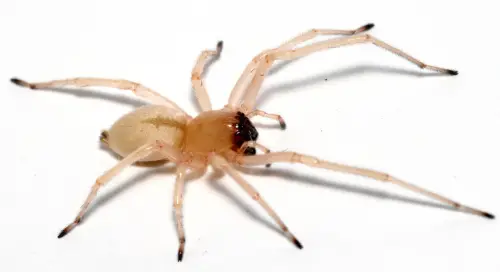
The long-legged sac spider, characterized by its diminutive size of approximately ¼ inch and its light yellow or cream-colored appearance, is a common arachnid species often encountered in indoor environments, particularly in the corners of rooms or on walls. Long-legged Sac Spiders have a darker thorax than abdomen. The center marking of the pale abdomen tapers off halfway down the belly and is thicker at the “waist.” While the majority of them are ivory and brown in color, some have dark yellow, pale green, or even white abdomens. Pale legs usually finish in very dark, or black, feet. This spider’s affinity for indoor spaces can often lead to unintended interactions with humans, prompting defensive behavior that may result in bites when the spider feels threatened or cornered.
In the event of a bite from the long-legged sac spider, individuals may experience an immediate and intense sensation of pain and burning at the site of the bite, often accompanied by localized redness and swelling. The initial discomfort associated with the spider’s venom can be particularly distressing, leading to persistent itching and the development of small, fluid-filled blisters that may exacerbate the overall discomfort and complicate the healing process.
While the bite of the long-legged sac spider can evoke considerable discomfort and localized skin reactions, it is essential to note that severe systemic reactions or long-term health consequences are generally rare. Most instances of bites from this spider species can be managed effectively through the application of basic first aid measures, aimed at alleviating pain, minimizing inflammation, and promoting the prompt resolution of skin irritations.
Conclusion
With these five types of poisonous spiders in Pennsylvania, recognizing their distinctive characteristics and potential dangers is crucial for ensuring personal safety. Identifying these spiders accurately and taking necessary precautions can help minimize the risks associated with their presence. Always consult a professional in case of any spider-related concerns for prompt and effective management.
People Who Read This Also Read:


